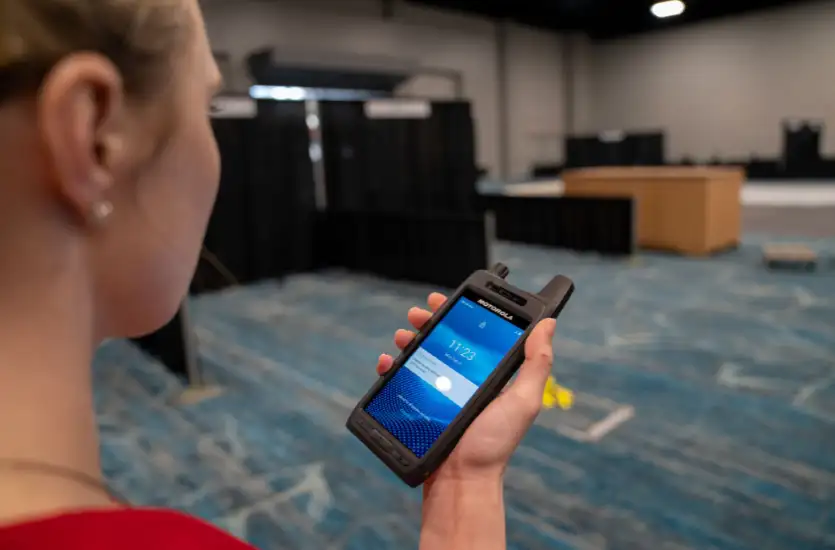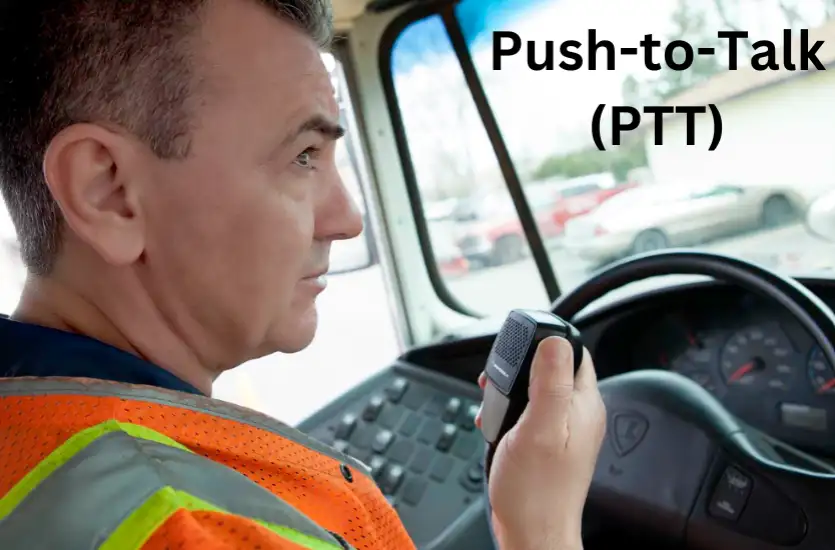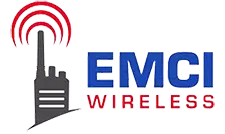We all know that communication has come a long way, from handwritten notes and landline calls to the rapid, tech-driven solutions we rely on today. As companies grow and the pace of work accelerates, instant, reliable communication has become more important than ever.
This is where Push-to-Talk (PTT) technology is changing the game. PTT allows users to communicate instantly by pressing a single button, making it easy for teams to stay connected without delay.
Whether through a radio or a smartphone app, PTT provides a quick, efficient way to send and receive messages. In this article, we’ll share some relevant insights on not just how PTT works, but why it may be advantageous to your business, no matter what industry you are in.
How Does Push-to-Talk (PTT) Technology Work?
Push-to-Talk (PTT) technology is designed to make communication as simple as possible. Unlike traditional phone calls, which require dialing and waiting for the other person to pick up, PTT allows instant voice communication. With PTT, you press a button, speak, and your message is instantly broadcast to others on the same network. This technology operates in voice broadcast and reception mode, meaning everyone in the group can hear the message as soon as it’s sent.
While 97% of Americans own a mobile phone, PTT offers something different. Cell phones are great for one-on-one or group calls, but they often lack the speed and simplicity needed for certain work environments. PTT is all about quick, efficient communication, which is why it’s widely used in industries like construction, transportation, and public safety.
PTT systems come in a few different forms:
- Cellular-Based PTT: Uses mobile networks to transmit messages, making it useful in urban areas with good coverage. Examples of Push-over-Cellular (PoC) radios that EMCI Wireless offers are the Motorola TLK 110 portable radio and the TLK 150 mobile radio.
- Radio-Based PTT: The specialty of EMCI Wireless, this system is built for durability and reliability, even in remote or challenging environments. It doesn’t rely on cell networks, making it ideal for areas with spotty or non-existent coverage. EMCI specializes in Motorola P25, MotoTRBO, Commercial radios and radio systems.
- PTT Apps: Brings PTT functionality to smartphones, blending modern convenience with traditional PTT features, like Motorola’s Wave PTX app.
While each system has its strengths, radio-based PTT remains the gold standard for many industries.

Advantages of PTT in Modern Business Communication
Let’s talk a bit about the advantages of PTT for today’s businesses. Obviously, the ability to communicate instantly is unrivaled and is a clear benefit. However, there is more to it than that, and if you are working on a business case to invest in PTT technology for your organization, having visibility to the wide gamut of benefits may help.
1. Instant Communication
When teams can relay information in real-time, they can make quick decisions, respond to challenges right away, and tackle problems before they get out of hand. This is where Push-to-Talk (PTT) technology comes in. Unlike traditional methods that may involve delays due to dialing or waiting for someone to pick up, PTT allows for immediate interaction with just the press of a button.
This instant communication is especially valuable in environments where time matters, like emergency services, construction sites, and logistics operations. With PTT, team members can quickly coordinate tasks, share updates, and react to changes, helping everything run more efficiently.
2. Efficiency and Productivity
Efficiency is a non-negotiable part of running a successful business; inefficiency can run you right into the ground. PTT technology keeps things on track. Traditional communication methods can be slow and frustrating, leading to delays and disruptions that cost time and money—not good for a business looking to scale and grow.
PTT technology, however, simplifies communication, keeping team members in constant contact. This immediate access to information helps prevent misunderstandings and cuts down on the time spent waiting for responses. Plus, PTT’s ability to connect multiple users at once means important updates and instructions can be shared with entire teams instantly. This reduces the need for repeated messages and helps everyone stay on the same page.
3. Cost-Effectiveness
PTT technology is not just about improving communication—it’s also a cost-effective solution for businesses. With their per-minute charges, maintenance costs, and hardware needs, traditional phone systems can add up quickly, especially for larger teams. PTT offers a more affordable alternative. Businesses can significantly reduce communication expenses by using radio networks or PTT apps on existing devices.
Worrying about high phone bills or investing in costly infrastructure is unnecessary. Instead, businesses can rely on PTT to provide reliable communication at a lower cost.
4. Scalability and Flexibility
One of the great things about PTT technology is how easily it can grow with a business. Whether running a small business or managing a large company with multiple locations, PTT can be scaled to fit your needs. The technology can quickly adapt to the growth of a business, allowing for more users and devices without needing significant changes to the communication setup.
PTT is also highly flexible and works well in lots of unique environments. It’s as effective in urban office settings as in remote, challenging locations. This adaptability makes PTT a practical choice for businesses looking for a communication system that can grow and change along with their needs.
5. Heightened Security
We all know today that security threats are a constant concern—the news channels are still replaying scenes from the assassination attempt on former President Trump and discussing all the security and communication breakdowns of the day.
To that end, the security features of PTT technology are a big plus. PTT systems often have built-in encryption and secure channels that protect sensitive communications from prying eyes. This level of security is a non-negotiable in industries like healthcare, public safety, and government, where the stakes are super high.
By using encrypted PTT channels, businesses can keep their communications safe from eavesdropping and cyber threats. This helps protect privacy and builds trust with clients and partners who expect their communications to be handled securely.
Industry Applications for PTT Technology
We have already mentioned several industries that can realize some big-time benefits from PTT radios—construction, transportation, government, healthcare, law enforcement, fire and emergency medical services, etc. But those aren’t the only industries that can benefit. Let’s dig a bit deeper into the benefits in the construction, transportation, and healthcare space and talk about how retailers and hospitality professionals can benefit as well.
Construction and Field Services
PTT technology coordinates teams across large construction sites and field services. Workers communicate instantly, share updates, and address issues as they arise, helping to prevent delays and accidents. PTT radios improve safety by allowing quick reporting of hazards or calls for assistance.
Transportation and Logistics
PTT is a must in fleet management and logistics operations. It keeps track of drivers, coordinates deliveries, and allows for real-time route adjustments. Instant communication reduces delays, improves efficiency, and lets drivers quickly report issues or request help.
Healthcare
PTT technology facilitates fast communication between medical staff, hospital first responders, and emergency services. It allows immediate information sharing, helping teams coordinate patient care and respond effectively to emergencies. It can literally be the difference in saving lives.
Retail and Hospitality
PTT technology improves customer service and internal communication in retail and hospitality settings. Store associates and hospitality staff use PTT to coordinate tasks, address customer needs, and respond to issues in real-time.

Integrating Push-to-Talk Radios with Other Business Communication Tools
Now that you are bought in on all the reasons why push-to-talk radios can be beneficial to your business, the natural question to ask is—how do I integrate two-way radios with the other communication tools already in place?
The first thing to remember here is that it can be challenging to create change in a work environment where people think things are already working. That said, it is important to help employees see the light, so to speak. By connecting PTT radios with smartphones and tablets, employees can use their devices to access PTT functions, allowing them to communicate instantly, on-site or on the go. This integration eliminates the need for multiple devices and that is something most people can quickly get on board with.
PTT can also be an instrumental component of a broader unified communication strategy. When combined with tools like email, video conferencing, and instant messaging, PTT fills the gap for real-time, voice-based communication that other tools may lack. This combination allows for a more comprehensive communication system where PTT handles immediate, urgent communication needs while other tools manage more detailed or formal communication. Sounds like a win-win, right?
Challenges and Considerations in Implementing PTT
As we alluded to above, we would be remiss not to acknowledge that some organizations face challenges when implementing push-to-talk communication devices. That’s where the team at EMCI Wireless in central and southern Florida can help. We work on understanding your specific communication needs, and can help you work through the challenges to prioritize an easier transition and help implement the right PTT solution for your organization.
Here are the objections and challenges that we typically see.
Technical Challenges
Implementing PTT technology can present technical challenges, such as network coverage limitations, device compatibility issues, and the need for reliable infrastructure. Organizations may also need to consider integrating PTT systems with existing communication tools. EMCI Wireless can assist in assessing these technical aspects and finding solutions that fit your needs.
Training and Adoption
Introducing a new communication tool like PTT requires proper training to help employees understand how to use the devices effectively. Resistance to change is expected, so we focus on providing the right training and address any concerns employees might have. EMCI Wireless can support your team in developing training materials and strategies to encourage widespread adoption and confident use of PTT technology.
Cost vs. Benefit Analysis
We’re back to that business case we mentioned before. The truth is that justifying the investment in PTT technology often requires a clear understanding of the cost vs. benefit. Organizations must evaluate the upfront costs of PTT devices and infrastructure against the long-term benefits, such as improved communication efficiency, reduced downtime, improved safety and potential cost savings.
Need help with your business case? EMCI Wireless can help you build a strong business case by providing insights into how PTT technology can drive value for your organization and deliver a solid return on investment.
The Power of Push-to-Talk in Modern Business Communication
Push-to-Talk (PTT) technology is significant in modern business communication, as it provides instant, reliable, and cost-effective solutions that keep teams connected. From improving efficiency and productivity to enabling security and flexibility, PTT can be used in almost every industry you can think of.
By integrating PTT with other communication tools, businesses can create a unified and efficient system that supports their operational needs. As you consider ways to strengthen your communication strategy, explore the benefits of PTT technology and how it can elevate your business.
Contact EMCI Wireless to learn how we can help you implement PTT solutions tailored to your organization’s needs.

